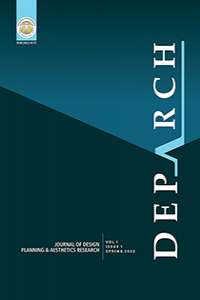Öz
This paper neither intends to construct a theoretical framework of the history of ornament nor focuses on its thresholds. Mainly, it aims to uncover the long-lost meanings of ornament by delving into the origins of the concept. It discusses the issue of “the function of ornament” today, mainly through The Function of Ornament (2006), edited by Farshid Moussavi and Michael Kubo. This book distinguishes itself from other current publications because it is one of the first works to discuss ornament from a new viewpoint by graphically analyzing a variety of twentieth and twenty-first-century buildings in terms of form, screen, structure, and surface. The book shows that ornament, as an integral element, is integrated to material, structure, and form, rather than being extrinsic and additional, which brings us to the etymology and the origins of the term. Thus, this paper explores what is considered as new in terms of ornament in contemporary architecture by analyzing case studies from the book.
Anahtar Kelimeler
Contemporary Architecture Envelope Farshid Moussavi Ornament The Function of Ornament
Destekleyen Kurum
Dokuz Eylül University, Scientific Research and Development Support Program
Proje Numarası
2010.KB.FEN.020.
Kaynakça
- Alberti, L. B. (1988). On the art of building in ten books. (J. Rykwert et al., trans.). Cambridge, MA: The MIT Press. (original publication in 1452).
- Balık, D. (2015). Deciphering ornament: Discourses and thresholds in architectural history. Vienna: Phoibos.
- Balık, D. (2016). A critical review of ornament in contemporary architectural theory and practice. ITU a/z, 13(1), 157-169. https://doi.org/10.5505/itujfa.2016.73745
- Chevrier, J.-F. & Herzog, J. (2006). Ornament, structure, space: A conversation with Jacques Herzog. El Croquis, 129-130, 22-40.
- Cicero. (1875). On oratory. (J. S. Watson, trans.). New York: Harper & Brothers. (original publication in 55 BCE).
- Jencks, C. (2011). The story of post-modernism: Five decades of the ironic, iconic and critical in architecture. West Sussex: John Wiley & Sons.
- Moussavi, F., & Kubo, M. (2006). The function of ornament. Barcelona: Actar.
- Pallister, J. (2009). CABE: Mecanoo’s Birmingham Library ‘not fully convincing’. Architects’ Journal, October, 8. https://www.architectsjournal.co.uk/archive/cabe-mecanoos-birmingham-library-not-fully-convincing
- Pliny the Elder. (1855). The natural history. (Henry T. Riley, trans.). London: H. G. Bohn. (original publication in 77-79 AD). https://www.perseus.tufts.edu/hopper/text?doc=Perseus%3Atext%3A1999.02.0137%3Abook%3D2%3Achapter%3D3
- Van Raaij, M. (2014). Building as ornament: Iconography in contemporary architecture. Rotterdam: Nai010.
- Venturi, R., Scott Brown, D., & Izenour, S. (1996). Learning from Las Vegas: The forgotten symbolism of architectural form. Cambridge, MA: The MIT Press. (original publication in 1972).
Öz
Proje Numarası
2010.KB.FEN.020.
Kaynakça
- Alberti, L. B. (1988). On the art of building in ten books. (J. Rykwert et al., trans.). Cambridge, MA: The MIT Press. (original publication in 1452).
- Balık, D. (2015). Deciphering ornament: Discourses and thresholds in architectural history. Vienna: Phoibos.
- Balık, D. (2016). A critical review of ornament in contemporary architectural theory and practice. ITU a/z, 13(1), 157-169. https://doi.org/10.5505/itujfa.2016.73745
- Chevrier, J.-F. & Herzog, J. (2006). Ornament, structure, space: A conversation with Jacques Herzog. El Croquis, 129-130, 22-40.
- Cicero. (1875). On oratory. (J. S. Watson, trans.). New York: Harper & Brothers. (original publication in 55 BCE).
- Jencks, C. (2011). The story of post-modernism: Five decades of the ironic, iconic and critical in architecture. West Sussex: John Wiley & Sons.
- Moussavi, F., & Kubo, M. (2006). The function of ornament. Barcelona: Actar.
- Pallister, J. (2009). CABE: Mecanoo’s Birmingham Library ‘not fully convincing’. Architects’ Journal, October, 8. https://www.architectsjournal.co.uk/archive/cabe-mecanoos-birmingham-library-not-fully-convincing
- Pliny the Elder. (1855). The natural history. (Henry T. Riley, trans.). London: H. G. Bohn. (original publication in 77-79 AD). https://www.perseus.tufts.edu/hopper/text?doc=Perseus%3Atext%3A1999.02.0137%3Abook%3D2%3Achapter%3D3
- Van Raaij, M. (2014). Building as ornament: Iconography in contemporary architecture. Rotterdam: Nai010.
- Venturi, R., Scott Brown, D., & Izenour, S. (1996). Learning from Las Vegas: The forgotten symbolism of architectural form. Cambridge, MA: The MIT Press. (original publication in 1972).
Ayrıntılar
| Birincil Dil | İngilizce |
|---|---|
| Konular | Mimarlık |
| Bölüm | Research Articles |
| Yazarlar | |
| Proje Numarası | 2010.KB.FEN.020. |
| Yayımlanma Tarihi | 6 Mayıs 2022 |
| Gönderilme Tarihi | 23 Ocak 2022 |
| Yayımlandığı Sayı | Yıl 2022 Cilt: 1 Sayı: 1 |
CREATIVE COMMONS
Open access articles in DEPARCH are licensed under a Creative Commons Attribution-NonCommercial 4.0 International License.



